A new proof for the security of the keyed sponge construction in the ideal compression function model
Since its introduction, the Sponge
construction [1] has been attracting research
attention in the cryptography community. It is
the fundamental of the SHA-3 standard Keccak
[2]. In the security model of Maurer [3], Bertoni
at el. [4] proved that the advantage in
differentiating the sponge construction from a
random oracle is upper bounded by 𝑂(𝑁2⁄2𝑐),
with N the number of calls to the underlying
function f and c the capacity.
Inspired by the introduction of keys into hash
functions as before and the beautiful theoretical
results of the sponge construction, designers
presented the keyed version for it:
Sponge(K‖M), we denote by KeyedSponge.
This manuscript is received July 10, 2019. It is commented
on August 16, 2019 and is accepted on August 23, 2019 by
the first reviewer. It is commented on September 30, 2019
and is accepted on October 6, 2019 by the second reviewer.
This version was proposed to build a wide
spectrum of symmetric-key primitive:
Reseedable pseudorandom number generator
[5], pseudorandom function and message
authentication codes (PRFs/MAC) [6, 7],
extendable-output functions [8] and
authenticated encryption modes [9]. Because of
its wide application, the security of the
KeyedSponge construction has been evaluated
in many documents and now it still attracts
interest from the cryptography community.
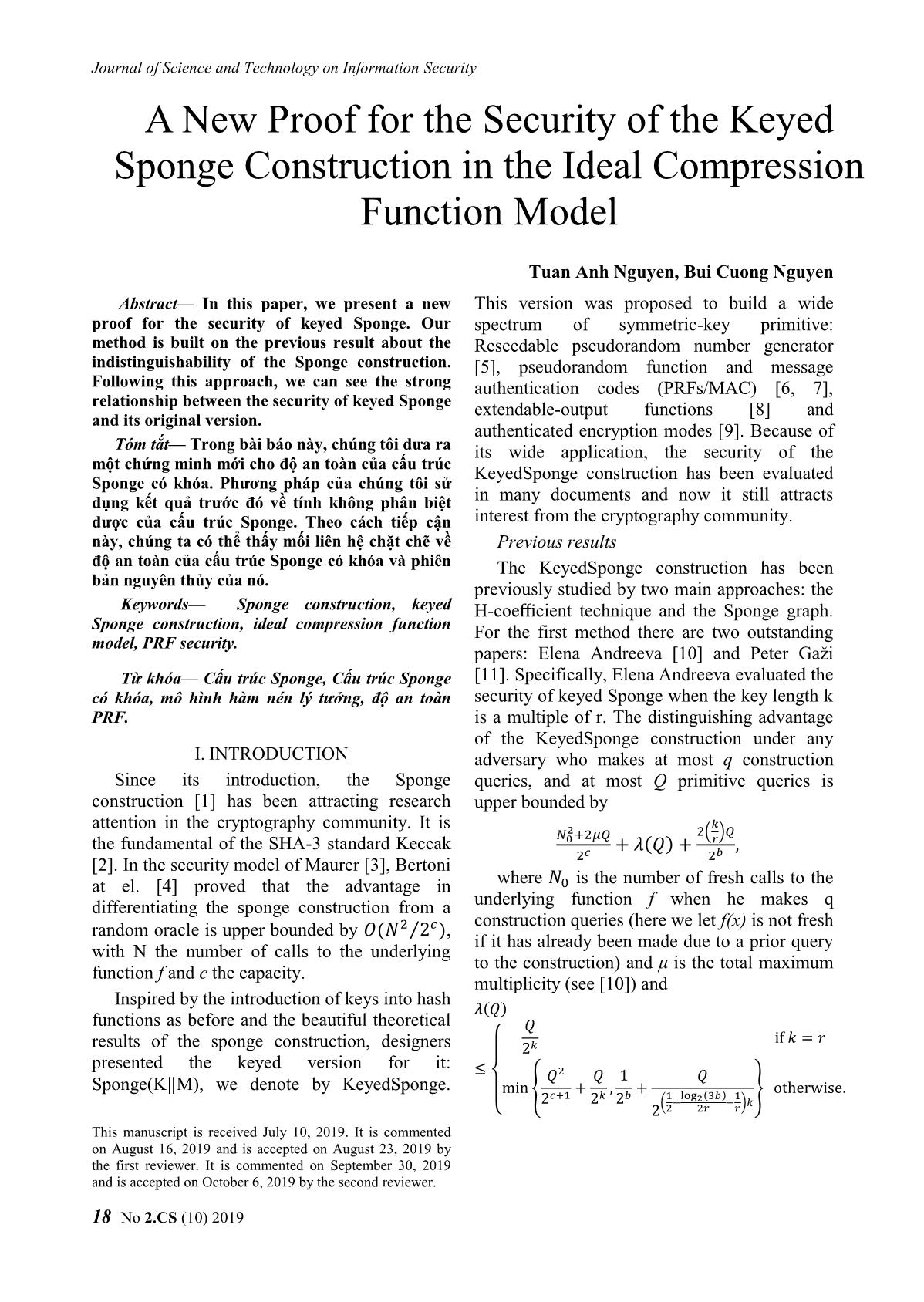
Trang 1
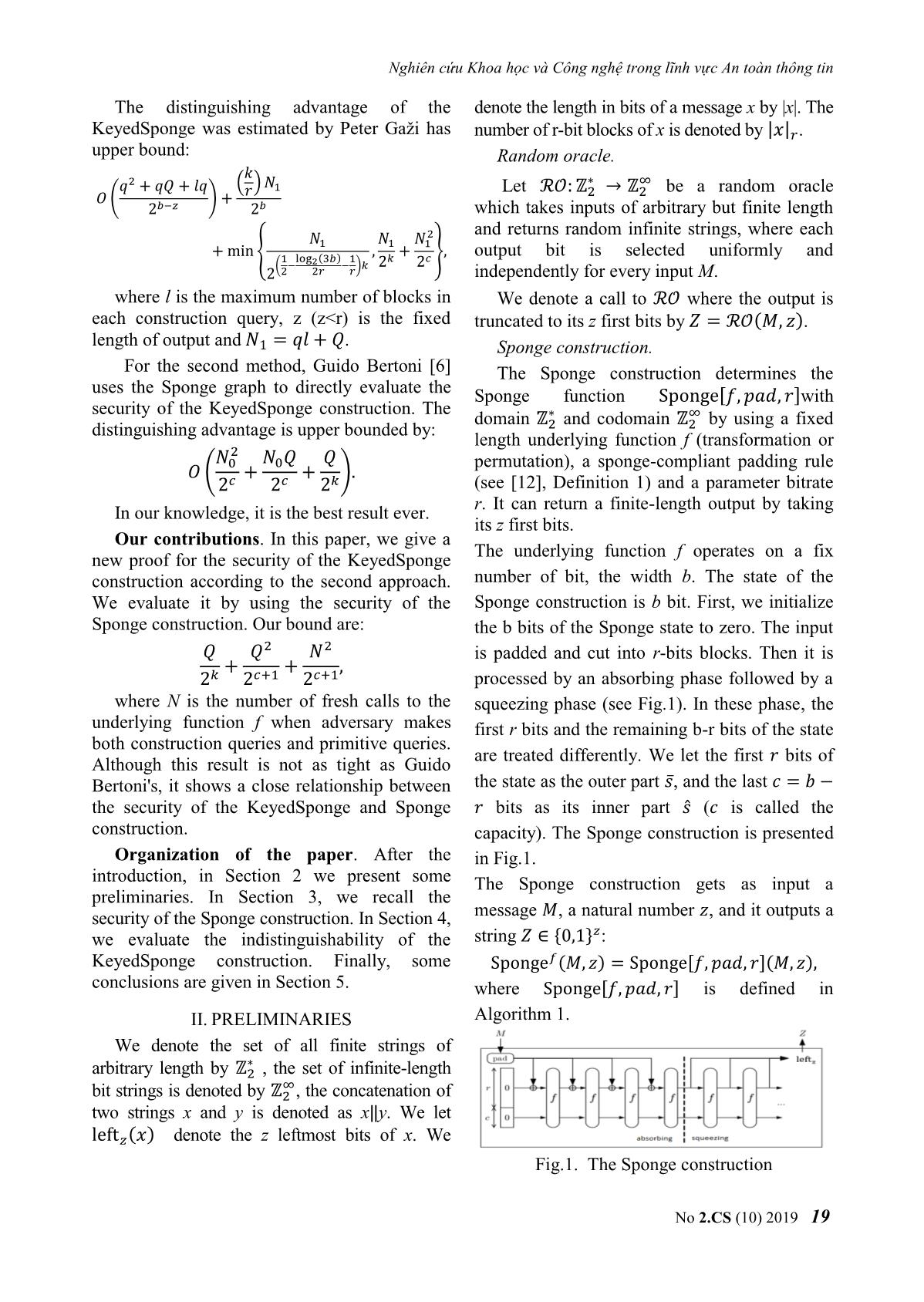
Trang 2
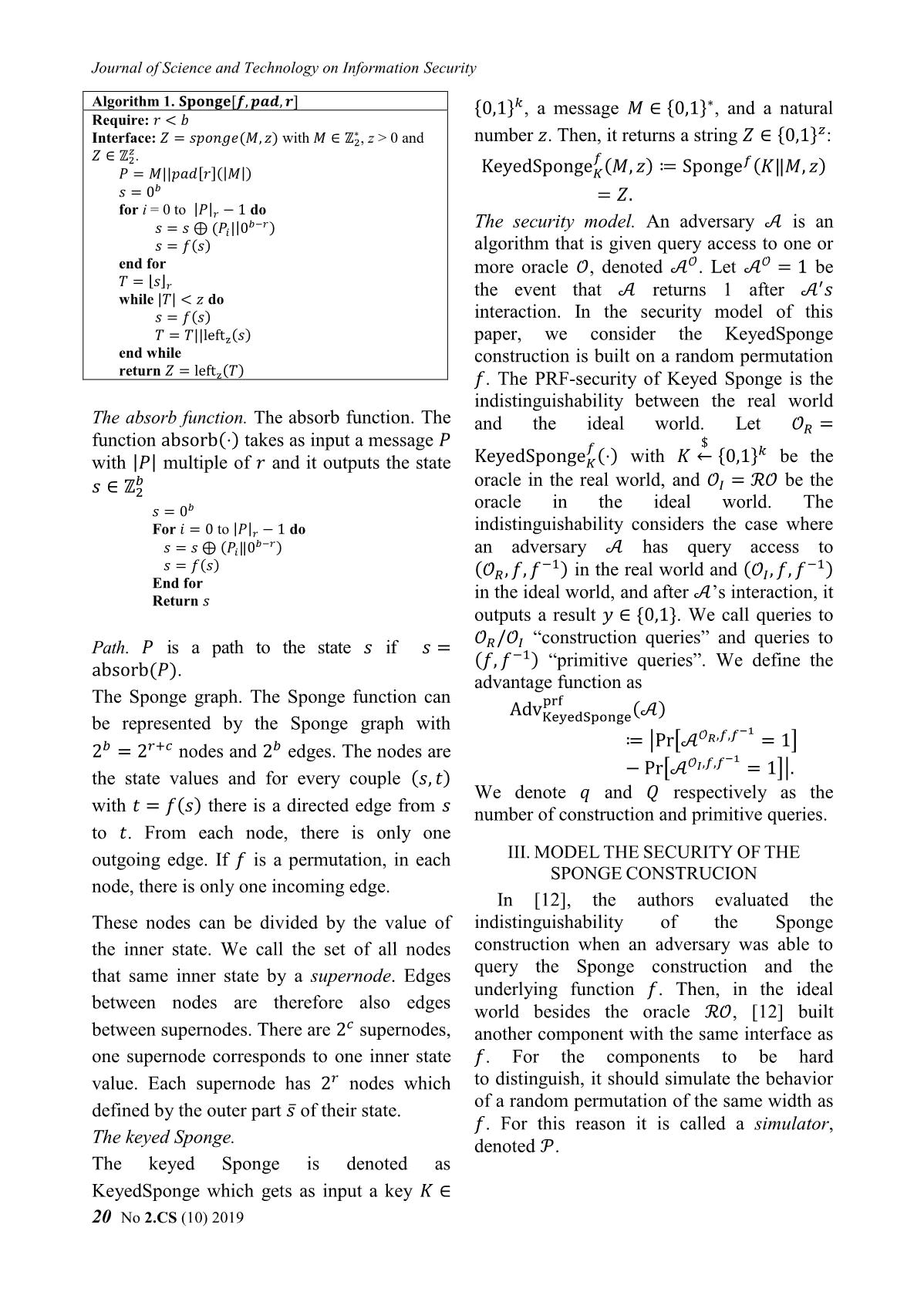
Trang 3
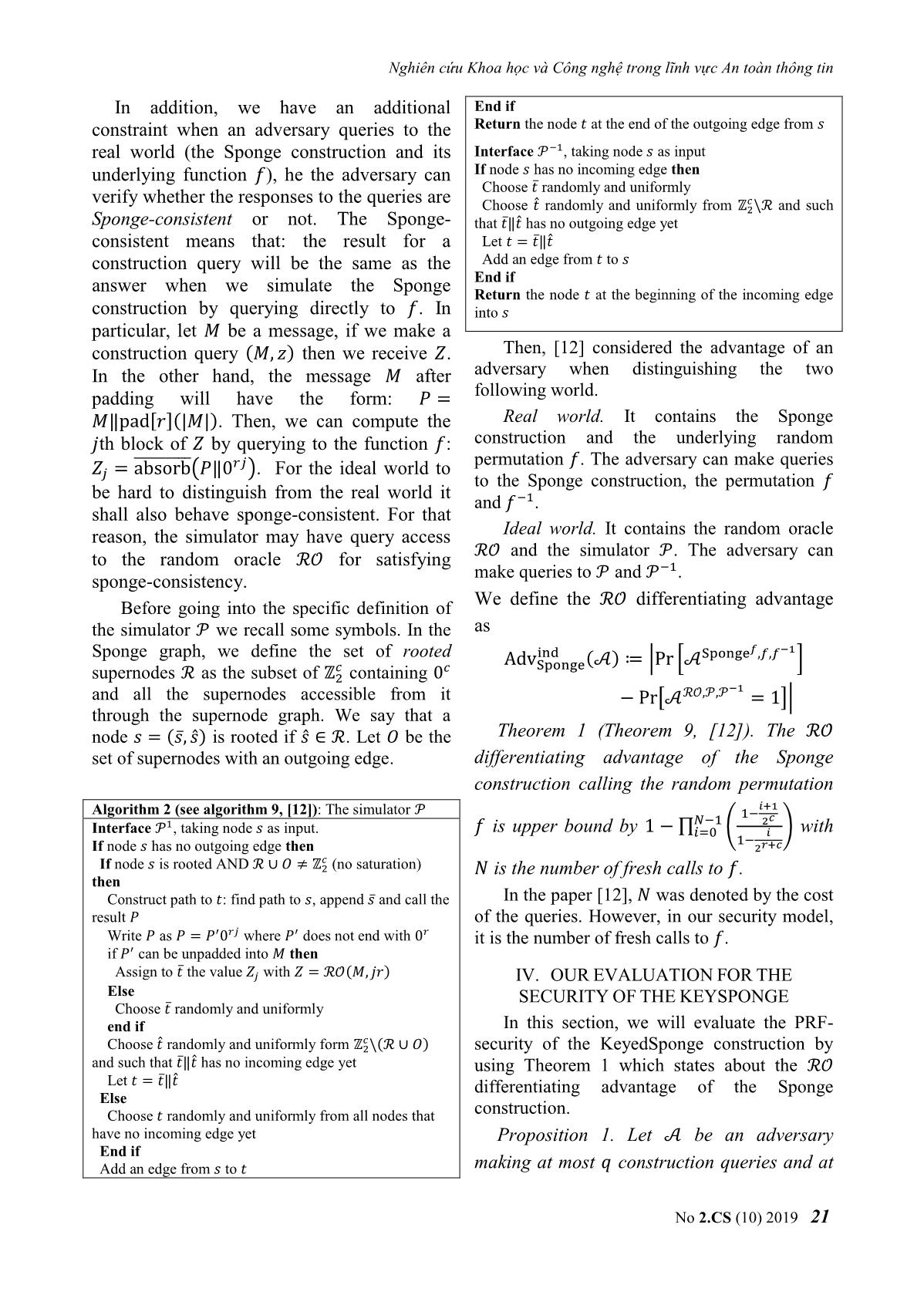
Trang 4
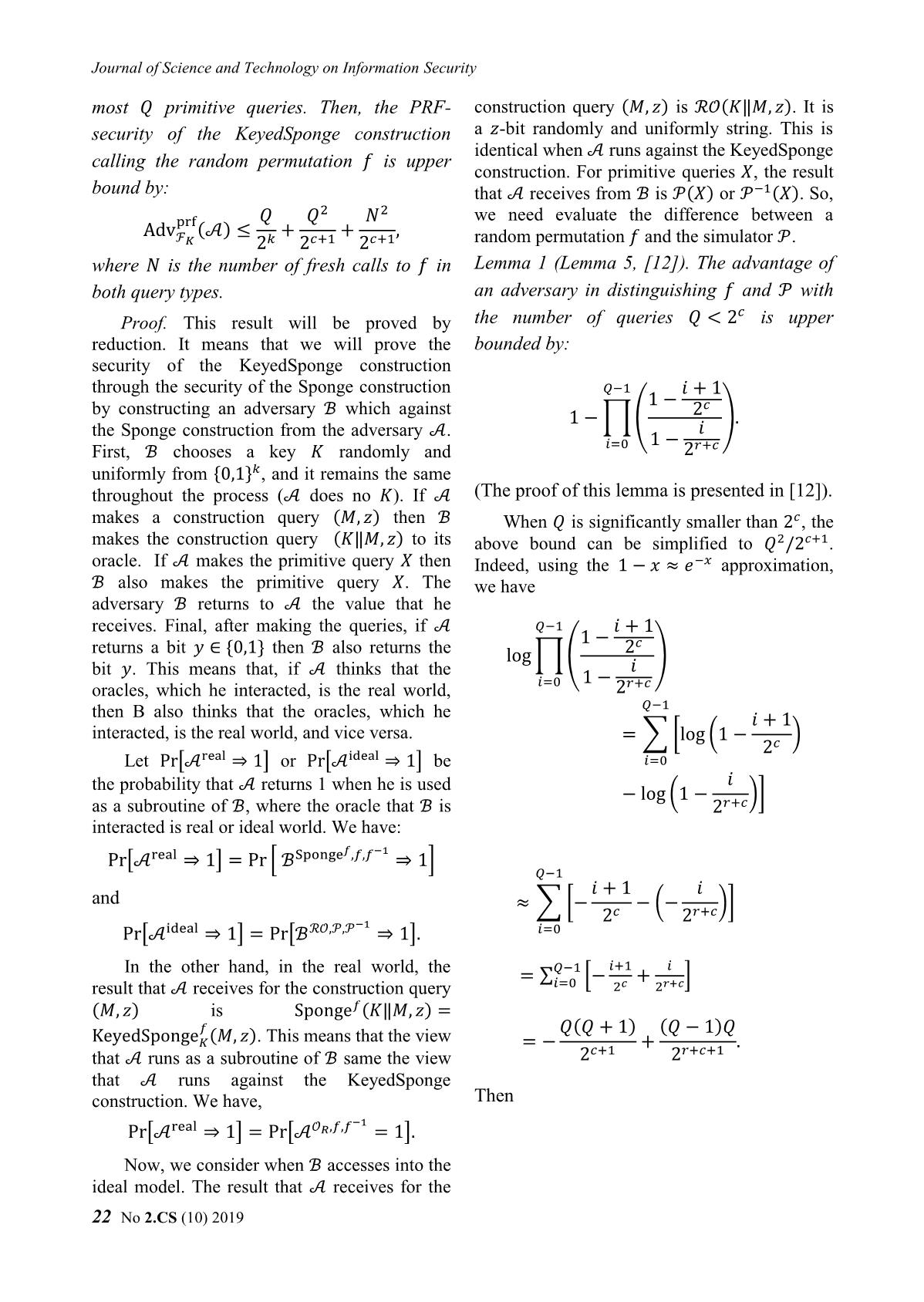
Trang 5
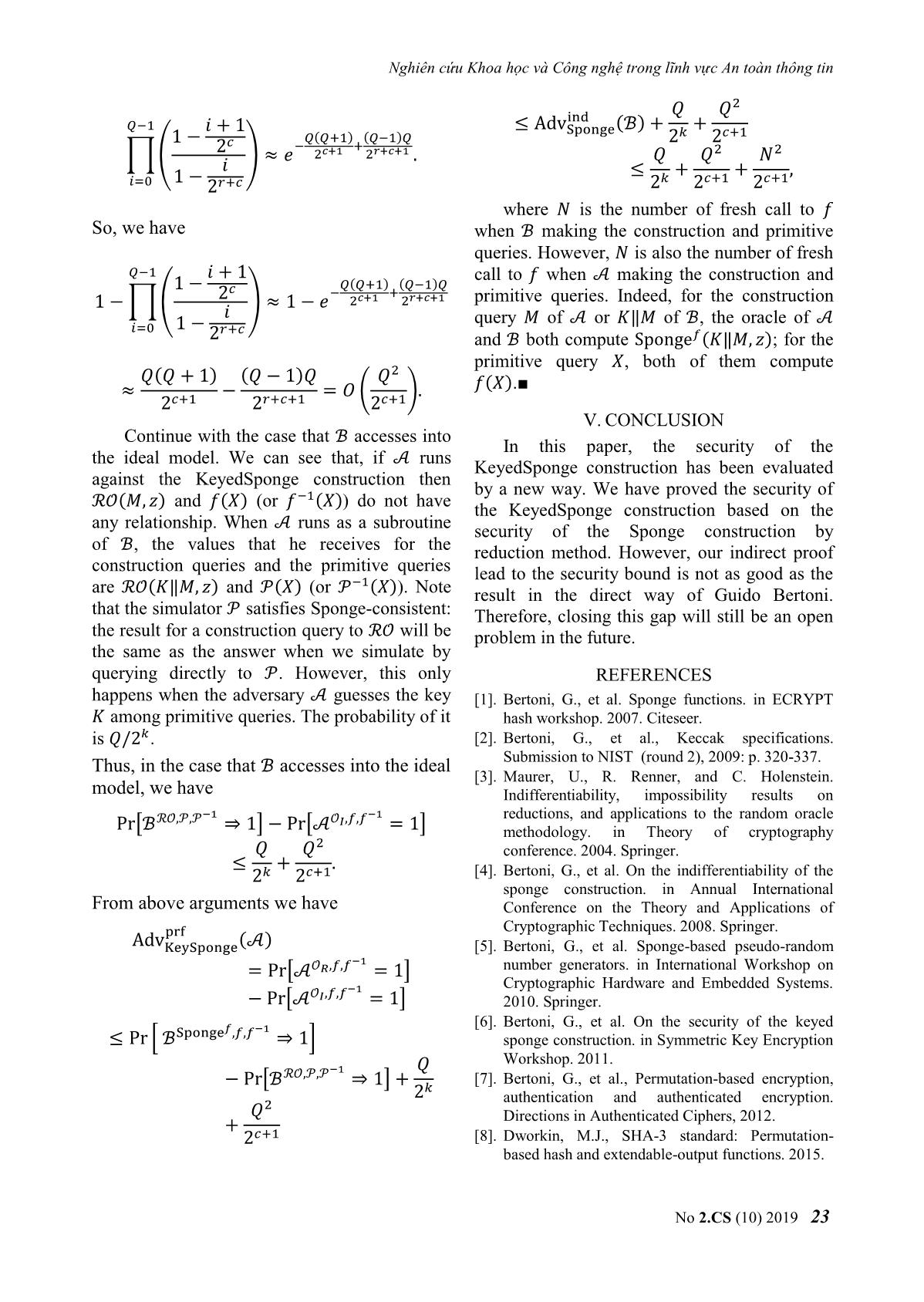
Trang 6
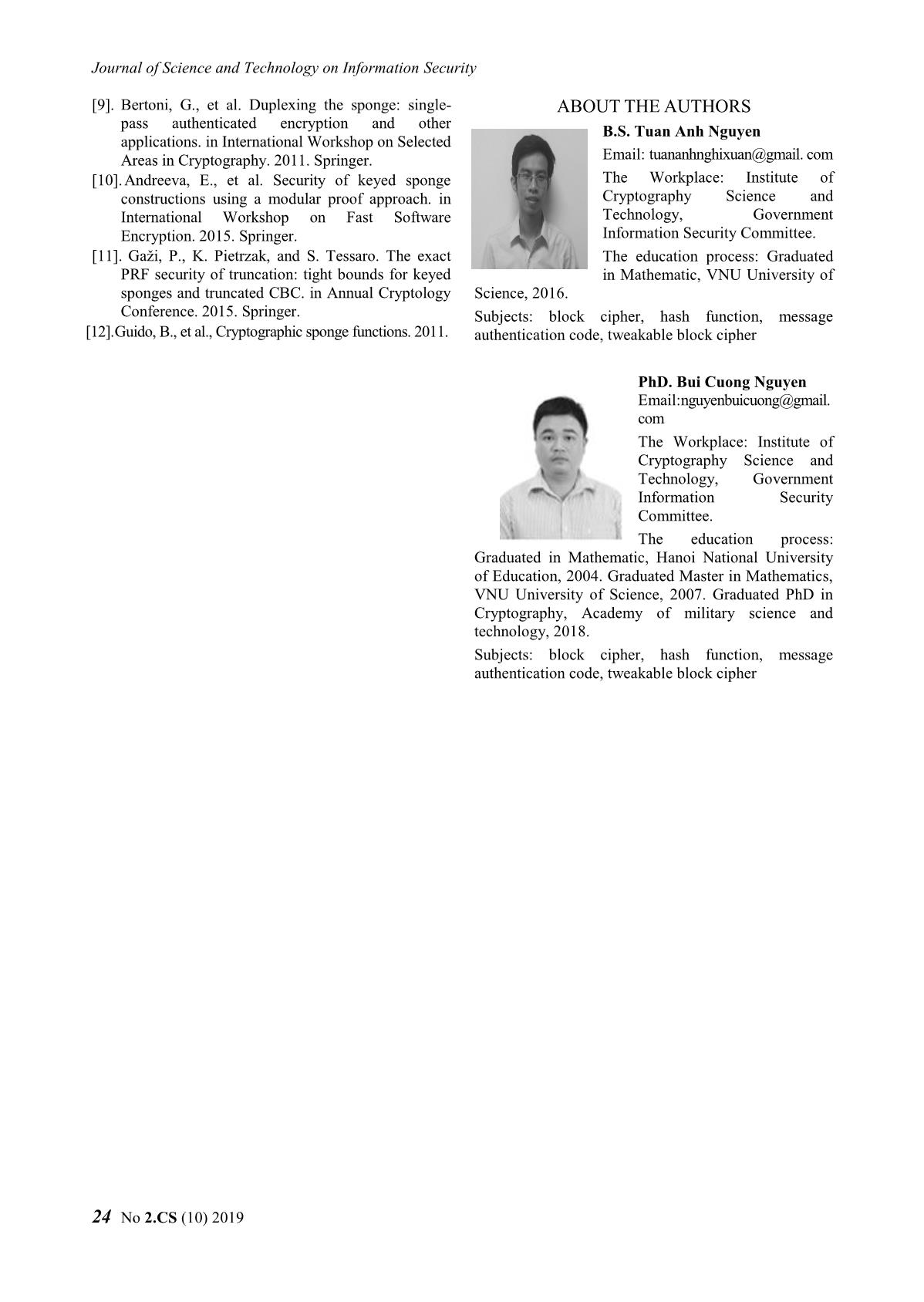
Trang 7
Tóm tắt nội dung tài liệu: A new proof for the security of the keyed sponge construction in the ideal compression function model
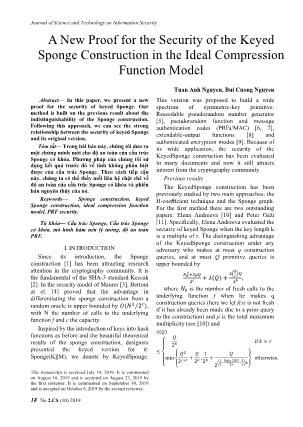
y length by ℤ2 , the set of infinite-length
∞
bit strings is denoted by ℤ2 , the concatenation of
two strings x and y is denoted as x‖y. We let
left ( ) denote the z leftmost bits of x. We
Fig.1. The Sponge construction
No 2.CS (10) 2019 19
Journal of Science and Technology on Information Security
Algorithm 1. 퐒퐩퐨퐧퐠퐞[풇, 풑 풅, 풓] {0,1} , a message ∈ {0,1}∗, and a natural
Require: <
∗
Interface: 푍 = 푠 표푛 푒( , ) with ∈ ℤ2, z > 0 and number . Then, it returns a string 푍 ∈ {0,1} :
푍 ∈ ℤ2.
푃 = || [ ](| |) KeyedSponge퐾( , ) ≔ Sponge (퐾‖ , )
푠 = 0 = 푍.
for i = 0 to |푃| − 1 do
− The security model. An adversary 𝒜 is an
푠 = 푠 ⊕ (푃푖||0 )
푠 = (푠) algorithm that is given query access to one or
end for more oracle 풪, denoted 𝒜풪. Let 𝒜풪 = 1 be
= ⌊푠⌋ the event that returns 1 after ′
while | | < do 𝒜 𝒜 푠
푠 = (푠) interaction. In the security model of this
= ||leftz(푠) paper, we consider the KeyedSponge
end while construction is built on a random permutation
return 푍 = left ( )
z . The PRF-security of Keyed Sponge is the
indistinguishability between the real world
The absorb function. The absorb function. The
and the ideal world. Let 풪푅 =
function absorb(⋅) takes as input a message 푃 $
with |푃| multiple of and it outputs the state KeyedSponge퐾(⋅) with 퐾 ← {0,1} be the
푠 ∈ ℤ oracle in the real world, and 풪 = ℛ풪 be the
2 oracle in the ideal world. The
푠 = 0
indistinguishability considers the case where
For 푖 = 0 to |푃| − 1 do
−
푠 = 푠 ⊕ (푃푖‖0 ) an adversary 𝒜 has query access to
푠 = (푠) −1 −1
(풪푅, , ) in the real world and (풪 , , )
End for
Return 푠 in the ideal world, and after 𝒜’s interaction, it
outputs a result ∈ {0,1}. We call queries to
풪 /풪 “construction queries” and queries to
Path. 푃 is a path to the state 푠 if 푠 = 푅
( , −1) “primitive queries”. We define the
absorb(푃).
advantage function as
The Sponge graph. The Sponge function can prf
AdvKeyedSponge(𝒜)
be represented by the Sponge graph with −1
풪푅, ,
+ ≔ |Pr[𝒜 = 1]
2 = 2 nodes and 2 edges. The nodes are −1
− Pr[𝒜풪 , , = 1]|.
the state values and for every couple (푠, 푡)
We denote 푞 and 푄 respectively as the
( )
with 푡 = 푠 there is a directed edge from 푠 number of construction and primitive queries.
to 푡. From each node, there is only one
outgoing edge. If is a permutation, in each III. MODEL THE SECURITY OF THE
SPONGE CONSTRUCION
node, there is only one incoming edge.
In [12], the authors evaluated the
These nodes can be divided by the value of indistinguishability of the Sponge
the inner state. We call the set of all nodes construction when an adversary was able to
that same inner state by a supernode. Edges query the Sponge construction and the
underlying function . Then, in the ideal
between nodes are therefore also edges world besides the oracle ℛ풪, [12] built
between supernodes. There are 2 supernodes, another component with the same interface as
one supernode corresponds to one inner state . For the components to be hard
value. Each supernode has 2 nodes which to distinguish, it should simulate the behavior
of a random permutation of the same width as
defined by the outer part 푠̅ of their state.
. For this reason it is called a simulator,
The keyed Sponge. denoted 풫.
The keyed Sponge is denoted as
KeyedSponge which gets as input a key 퐾 ∈
20 No 2.CS (10) 2019
Nghiên cứu Khoa học và Công nghệ trong lĩnh vực An toàn thông tin
In addition, we have an additional End if
constraint when an adversary queries to the Return the node 푡 at the end of the outgoing edge from 푠
real world (the Sponge construction and its Interface 풫−1, taking node 푠 as input
underlying function ), he the adversary can If node 푠 has no incoming edge then
Choose 푡 ̅ randomly and uniformly
verify whether the responses to the queries are
Choose 푡̂ randomly and uniformly from ℤ2\ℛ and such
Sponge-consistent or not. The Sponge- that 푡‖̅ 푡̂ has no outgoing edge yet
consistent means that: the result for a Let 푡 = 푡‖̅ 푡̂
construction query will be the same as the Add an edge from 푡 to 푠
End if
answer when we simulate the Sponge Return the node 푡 at the beginning of the incoming edge
construction by querying directly to . In into 푠
particular, let be a message, if we make a
construction query ( , ) then we receive 푍. Then, [12] considered the advantage of an
In the other hand, the message after adversary when distinguishing the two
padding will have the form: 푃 = following world.
‖pad[ ](| |). Then, we can compute the Real world. It contains the Sponge
푗th block of 푍 by querying to the function : construction and the underlying random
푍 = absorb̅̅̅̅̅̅̅̅̅(푃‖0 푗). For the ideal world to permutation . The adversary can make queries
푗 to the Sponge construction, the permutation
be hard to distinguish from the real world it
and −1.
shall also behave sponge-consistent. For that
reason, the simulator may have query access Ideal world. It contains the random oracle
to the random oracle ℛ풪 for satisfying ℛ풪 and the simulator 풫. The adversary can
make queries to 풫 and 풫−1.
sponge-consistency.
Before going into the specific definition of We define the ℛ풪 differentiating advantage
the simulator 풫 we recall some symbols. In the as
Sponge graph, we define the set of rooted ind Sponge , , −1
AdvSponge(𝒜) ≔ |Pr [𝒜 ]
supernodes ℛ as the subset of ℤ2 containing 0
−1
and all the supernodes accessible from it − Pr[𝒜ℛ풪,풫,풫 = 1]|
through the supernode graph. We say that a
node 푠 = (푠̅, 푠̂) is rooted if 푠̂ ∈ ℛ. Let be the Theorem 1 (Theorem 9, [12]). The ℛ풪
set of supernodes with an outgoing edge. differentiating advantage of the Sponge
construction calling the random permutation
Algorithm 2 (see algorithm 9, [12]): The simulator 풫 푖+1
1−
1 −1 2
Interface 풫 , taking node 푠 as input. is upper bound by 1 − ∏푖=0 ( 푖 ) with
1−
If node 푠 has no outgoing edge then 2 +
If node 푠 is rooted AND ℛ ∪ ≠ ℤ2 (no saturation) is the number of fresh calls to .
then
Construct path to 푡: find path to 푠, append 푠̅ and call the In the paper [12], was denoted by the cost
result 푃 of the queries. However, in our security model,
Write 푃 as 푃 = 푃′0 푗 where 푃′ does not end with 0 it is the number of fresh calls to .
if 푃′ can be unpadded into then
Assign to 푡 ̅ the value 푍푗 with 푍 = ℛ풪( , 푗 ) IV. OUR EVALUATION FOR THE
Else SECURITY OF THE KEYSPONGE
Choose 푡 ̅ randomly and uniformly
end if In this section, we will evaluate the PRF-
Choose 푡̂ randomly and uniformly form ℤ2\(ℛ ∪ ) security of the KeyedSponge construction by
and such that 푡‖̅ 푡̂ has no incoming edge yet using Theorem 1 which states about the ℛ풪
Let 푡 = 푡‖̅ 푡̂ differentiating advantage of the Sponge
Else
Choose 푡 randomly and uniformly from all nodes that construction.
have no incoming edge yet Proposition 1. Let 𝒜 be an adversary
End if
Add an edge from 푠 to 푡 making at most 푞 construction queries and at
No 2.CS (10) 2019 21
Journal of Science and Technology on Information Security
most 푄 primitive queries. Then, the PRF- construction query ( , ) is ℛ풪(퐾‖ , ). It is
security of the KeyedSponge construction a -bit randomly and uniformly string. This is
identical when 𝒜 runs against the KeyedSponge
calling the random permutation is upper
construction. For primitive queries , the result
bound by: that 𝒜 receives from ℬ is 풫( ) or 풫−1( ). So,
푄 푄2 2 we need evaluate the difference between a
Advprf(𝒜) ≤ + + ,
ℱ퐾 2 2 +1 2 +1 random permutation and the simulator 풫.
where is the number of fresh calls to in Lemma 1 (Lemma 5, [12]). The advantage of
both query types. an adversary in distinguishing and 풫 with
Proof. This result will be proved by the number of queries 푄 < 2 is upper
reduction. It means that we will prove the bounded by:
security of the KeyedSponge construction
through the security of the Sponge construction 푄−1 푖 + 1
1 −
by constructing an adversary ℬ which against 1 − ∏ ( 2 ).
푖
the Sponge construction from the adversary 𝒜. 1 −
First, ℬ chooses a key 퐾 randomly and 푖=0 2 +
uniformly from {0,1} , and it remains the same
throughout the process (𝒜 does no 퐾). If 𝒜 (The proof of this lemma is presented in [12]).
makes a construction query ( , ) then ℬ When 푄 is significantly smaller than 2 , the
makes the construction query (퐾‖ , ) to its above bound can be simplified to 푄2/2 +1.
oracle. If 𝒜 makes the primitive query then Indeed, using the 1 − ≈ 푒− approximation,
ℬ also makes the primitive query . The we have
adversary ℬ returns to 𝒜 the value that he
receives. Final, after making the queries, if 𝒜 푄−1 푖 + 1
1 −
returns a bit ∈ {0,1} then ℬ also returns the log ∏ ( 2 )
푖
bit . This means that, if 𝒜 thinks that the 1 −
oracles, which he interacted, is the real world, 푖=0 2 +
푄−1
then B also thinks that the oracles, which he 푖 + 1
interacted, is the real world, and vice versa. = ∑ [log (1 − )
2
Let Pr[𝒜real ⇒ 1] or Pr[𝒜ideal ⇒ 1] be 푖=0
the probability that returns 1 when he is used 푖
𝒜 − log (1 − )]
as a subroutine of ℬ, where the oracle that ℬ is 2 +
interacted is real or ideal world. We have:
−1
Pr[𝒜real ⇒ 1] = Pr [ ℬSponge , , ⇒ 1]
푄−1
푖 + 1 푖
and
≈ ∑ [− − (− + )]
−1 2 2
Pr[𝒜ideal ⇒ 1] = Pr[ℬℛ풪,풫,풫 ⇒ 1]. 푖=0
푖+1 푖
In the other hand, in the real world, the = ∑푄−1 [− + ]
result that 𝒜 receives for the construction query 푖=0 2 2 +
( , ) is Sponge (퐾‖ , ) =
푄(푄 + 1) (푄 − 1)푄
KeyedSponge퐾( , ). This means that the view = − + .
that 𝒜 runs as a subroutine of ℬ same the view 2 +1 2 + +1
that 𝒜 runs against the KeyedSponge
construction. We have, Then
−1
Pr[𝒜real ⇒ 1] = Pr[𝒜풪푅, , = 1].
Now, we consider when ℬ accesses into the
ideal model. The result that 𝒜 receives for the
22 No 2.CS (10) 2019
Nghiên cứu Khoa học và Công nghệ trong lĩnh vực An toàn thông tin
2
ind 푄 푄
푄−1 푖 + 1 ≤ AdvSponge(ℬ) + + +1
1 − 푄(푄+1) (푄−1)푄 2 2
2 − + 2 2
∏ ( ) ≈ 푒 2 +1 2 + +1 . 푄 푄
푖
1 − ≤ + +1 + +1,
푖=0 2 + 2 2 2
where is the number of fresh call to
So, we have when ℬ making the construction and primitive
queries. However, is also the number of fresh
푄−1 푖 + 1 call to when 𝒜 making the construction and
1 − 푄(푄+1) (푄−1)푄
2 − +
1 − ∏ ( ) ≈ 1 − 푒 2 +1 2 + +1 primitive queries. Indeed, for the construction
푖 query of 𝒜 or 퐾‖ of ℬ, the oracle of 𝒜
푖=0 1 − +
2 and ℬ both compute Sponge (퐾‖ , ); for the
primitive query , both of them compute
푄(푄 + 1) (푄 − 1)푄 푄2
≈ − = ( ). ( ).■
2 +1 2 + +1 2 +1
V. CONCLUSION
Continue with the case that ℬ accesses into
In this paper, the security of the
the ideal model. We can see that, if 𝒜 runs
KeyedSponge construction has been evaluated
against the KeyedSponge construction then
by a new way. We have proved the security of
ℛ풪( , ) and ( ) (or −1( )) do not have
the KeyedSponge construction based on the
any relationship. When 𝒜 runs as a subroutine security of the Sponge construction by
of ℬ, the values that he receives for the reduction method. However, our indirect proof
construction queries and the primitive queries
−1 lead to the security bound is not as good as the
are ℛ풪(퐾‖ , ) and 풫( ) (or 풫 ( )). Note result in the direct way of Guido Bertoni.
that the simulator 풫 satisfies Sponge-consistent: Therefore, closing this gap will still be an open
the result for a construction query to ℛ풪 will be problem in the future.
the same as the answer when we simulate by
querying directly to 풫. However, this only REFERENCES
happens when the adversary 𝒜 guesses the key [1]. Bertoni, G., et al. Sponge functions. in ECRYPT
퐾 among primitive queries. The probability of it hash workshop. 2007. Citeseer.
is 푄/2 . [2]. Bertoni, G., et al., Keccak specifications.
Thus, in the case that ℬ accesses into the ideal Submission to NIST (round 2), 2009: p. 320-337.
[3]. Maurer, U., R. Renner, and C. Holenstein.
model, we have Indifferentiability, impossibility results on
−1 −1 reductions, and applications to the random oracle
ℛ풪,풫,풫 풪 , ,
Pr[ℬ ⇒ 1] − Pr[𝒜 = 1] methodology. in Theory of cryptography
푄 푄2 conference. 2004. Springer.
≤ + .
2 2 +1 [4]. Bertoni, G., et al. On the indifferentiability of the
sponge construction. in Annual International
From above arguments we have Conference on the Theory and Applications of
prf Cryptographic Techniques. 2008. Springer.
AdvKeySponge(𝒜) [5]. Bertoni, G., et al. Sponge-based pseudo-random
−1
= Pr[𝒜풪푅, , = 1] number generators. in International Workshop on
Cryptographic Hardware and Embedded Systems.
풪 , , −1
− Pr[𝒜 = 1] 2010. Springer.
−1 [6]. Bertoni, G., et al. On the security of the keyed
≤ Pr [ ℬSponge , , ⇒ 1] sponge construction. in Symmetric Key Encryption
Workshop. 2011.
−1 푄
ℛ풪,풫,풫 [7]. Bertoni, G., et al., Permutation-based encryption,
− Pr[ℬ ⇒ 1] +
2 authentication and authenticated encryption.
푄2
+ Directions in Authenticated Ciphers, 2012.
2 +1 [8]. Dworkin, M.J., SHA-3 standard: Permutation-
based hash and extendable-output functions. 2015.
No 2.CS (10) 2019 23
Journal of Science and Technology on Information Security
[9]. Bertoni, G., et al. Duplexing the sponge: single- ABOUT THE AUTHORS
pass authenticated encryption and other
B.S. Tuan Anh Nguyen
applications. in International Workshop on Selected
Areas in Cryptography. 2011. Springer. Email: tuananhnghixuan@gmail. com
[10]. Andreeva, E., et al. Security of keyed sponge The Workplace: Institute of
constructions using a modular proof approach. in Cryptography Science and
International Workshop on Fast Software Technology, Government
Encryption. 2015. Springer. Information Security Committee.
[11]. Gaži, P., K. Pietrzak, and S. Tessaro. The exact The education process: Graduated
PRF security of truncation: tight bounds for keyed in Mathematic, VNU University of
sponges and truncated CBC. in Annual Cryptology Science, 2016.
Conference. 2015. Springer. Subjects: block cipher, hash function, message
[12]. Guido, B., et al., Cryptographic sponge functions. 2011. authentication code, tweakable block cipher
PhD. Bui Cuong Nguyen
Email:nguyenbuicuong@gmail.
com
The Workplace: Institute of
Cryptography Science and
Technology, Government
Information Security
Committee.
The education process:
Graduated in Mathematic, Hanoi National University
of Education, 2004. Graduated Master in Mathematics,
VNU University of Science, 2007. Graduated PhD in
Cryptography, Academy of military science and
technology, 2018.
Subjects: block cipher, hash function, message
authentication code, tweakable block cipher
24 No 2.CS (10) 2019
File đính kèm:
 a_new_proof_for_the_security_of_the_keyed_sponge_constructio.pdf
a_new_proof_for_the_security_of_the_keyed_sponge_constructio.pdf

